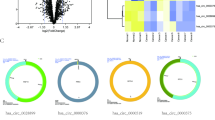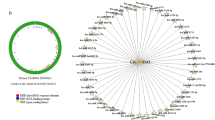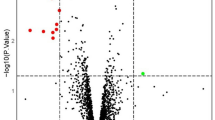Abstract
Circular RNAs (circRNAs) possess valuable characteristics for both diagnosis and treatment of several human cancers including breast cancer (BC). In this study, we combined several systems, biology tools and approaches to identify influential BC circRNAs, miRNAs, and related mRNAs as the members of competing endogenous RNAs (ceRNAs) networks and related RNA binding proteins (RBPs) to study and decipher the BC-triggering biological processes and pathways. Rooting from the identified total of 25 co-differentially expressed circRNAs (DECs) between triple negative (TN) and luminal A subtypes of BC from microarray analysis, five hub DECs (hsa_circ_0003227, hsa_circ_0001955, hsa_circ_0020080, hsa_circ_0001666, and hsa_circ_0065173) and top eleven RBPs (AGO1, AGO2, EIF4A3, FMRP, HuR (ELAVL1), IGF2BP1, IGF2BP2, IGF2BP3, EWSR1, FUS, and PTB) were explored to form the upper stream regulatory elements. All the hub circRNAs were regarded as a super sponge having multiple miRNA response elements (MREs). Then, three BC leading miRNAs (hsa-miR-149, hsa-miR-182, and hsa-miR-383) were also introduced from merging several established ceRNAs networks. The predicted 7- and 8-mer MREs matches between hub circRNAs and leading miRNAs ensured their enduring regulatory capability. The mined downstream mRNAs of the circRNAs–miRNAs network then were presented to STRING database to form the PPI network and to decipher the issue from another point of view. The BC interconnected enriched pathways and processes guarantee the merits of the ceRNAs network’s members as targetable therapeutic elements. This study suggested extensive panels of novel therapeutic targets that are in charge of BC progression, hence their impressive role cannot be excluded and needs deeper empirical laboratory designs.





Similar content being viewed by others
References
Siegel RL, Miller KD (2017) Jemal A (2017) Cancer statistics. CA Cancer J Clin 67(1):7–30
Salmena L, Poliseno L, Tay Y, Kats L, Pandolfi PP (2011) A ceRNA hypothesis: the Rosetta stone of a hidden RNA language? Cell 146(3):353–358
Bosson AD, Zamudio JR, Sharp PA (2014) Endogenous miRNA and target concentrations determine susceptibility to potential ceRNA competition. Mol Cell 56(3):347–359
Yang Y, Fan X, Mao M, Song X, Wu P, Zhang Y, Jin Y, Yang Y, Chen L-L, Wang Y (2017) Extensive translation of circular RNAs driven by N 6-methyladenosine. Cell Res 27(5):626
Danan M, Schwartz S, Edelheit S, Sorek R (2011) Transcriptome-wide discovery of circular RNAs in Archaea. Nucleic Acids Res 40(7):3131–3142
Zhang X-O, Wang H-B, Zhang Y, Lu X, Chen L-L, Yang L (2014) Complementary sequence-mediated exon circularization. Cell 159(1):134–147
Zhang Y, Zhang X-O, Chen T, Xiang J-F, Yin Q-F, Xing Y-H, Zhu S, Yang L, Chen L-L (2013) Circular intronic long noncoding RNAs. Mol Cell 51(6):792–806
Li Z, Huang C, Bao C, Chen L, Lin M, Wang X, Zhong G, Yu B, Hu W, Dai L (2015) Exon-intron circular RNAs regulate transcription in the nucleus. Nat Struct Mol Biol 22(3):256
Xu S, Zhou L, Ponnusamy M, Zhang L, Dong Y, Zhang Y, Wang Q, Liu J, Wang K (2018) A comprehensive review of circRNA: from purification and identification to disease marker potential. PeerJ 6:e5503
Lü L, Sun J, Shi P, Kong W, Xu K, He B, Zhang S, Wang J (2017) Identification of circular RNAs as a promising new class of diagnostic biomarkers for human breast cancer. Oncotarget 8(27):44096
Wu J, Jiang Z, Chen C, Hu Q, Fu Z, Chen J, Wang Z, Wang Q, Li A, Marks JR (2018) CircIRAK3 sponges miR-3607 to facilitate breast cancer metastasis. Cancer Lett 430:179–192
Liang H-F, Zhang X-Z, Liu B-G, Jia G-T, Li W-L (2017) Circular RNA circ-ABCB10 promotes breast cancer proliferation and progression through sponging miR-1271. Am J Cancer Res 7(7):1566
Nasri-Nasrabadi P, Zareian S, Nayeri Z, Salmanipour R, Parsafar S, Gharib E, Asadzadeh-Aghdaei H, Zali MR (2019) A detailed image of rutin underlying intracellular signaling pathways in human SW480 colorectal cancer cells based on miRNAs-lncRNAs-mRNAs-TFs interactions. J Cell Physiol 234(9):15570–15580
Gharib E, Kouhsari SM, Izad M (2018) Punica granatum L Fruit aqueous extract suppresses reactive oxygen species-mediated p53/p65/miR-145 expressions followed by elevated levels of irs-1 in alloxan-diabetic rats. Cell J 19(4):520
Cai Y, Yu X, Hu S, Yu J (2009) A brief review on the mechanisms of miRNA regulation. Genom Proteom Bioinform 7(4):147–154
O'Day E, Lal A (2010) MicroRNAs and their target gene networks in breast cancer. Breast Cancer Res 12(2):201
Imani S, Wei C, Cheng J, Khan MA, Fu S, Yang L, Tania M, Zhang X, Xiao X, Zhang X (2017) MicroRNA-34a targets epithelial to mesenchymal transition-inducing transcription factors (EMT-TFs) and inhibits breast cancer cell migration and invasion. Oncotarget 8(13):21362
Li P, Sheng C, Huang L, Zhang H, Huang L, Cheng Z, Zhu Q (2014) MiR-183/-96/-182 cluster is up-regulated in most breast cancers and increases cell proliferation and migration. Breast Cancer Res 16(6):473
Abdelmohsen K, Gorospe M (2010) Posttranscriptional regulation of cancer traits by HuR. Wiley Interdiscip Rev RNA 1(2):214–229
Hentze MW, Preiss T (2013) Circular RNAs: splicing's enigma variations. EMBO J 32(7):923–925
Lécuyer E, Yoshida H, Parthasarathy N, Alm C, Babak T, Cerovina T, Hughes TR, Tomancak P, Krause HM (2007) Global analysis of mRNA localization reveals a prominent role in organizing cellular architecture and function. Cell 131(1):174–187
Glisovic T, Bachorik JL, Yong J, Dreyfuss G (2008) RNA-binding proteins and post-transcriptional gene regulation. FEBS Lett 582(14):1977–1986
Zheng L, Zhang Z, Zhang S, Guo Q, Zhang F, Gao L, Ni H, Guo X, Xiang C, Xi T (2018) RNA binding protein RNPC1 inhibits breast cancer cell metastasis via activating STARD13-correlated ceRNA network. Mol Pharm 15(6):2123–2132
Guo X, Hartley RS (2006) HuR contributes to cyclin E1 deregulation in MCF-7 breast cancer cells. Can Res 66(16):7948–7956
Maubant S, Tesson B, Maire V, Ye M, Rigaill G, Gentien D, Cruzalegui F, Tucker GC, Roman-Roman S, Dubois T (2015) Transcriptome analysis of Wnt3a-treated triple-negative breast cancer cells. PLoS ONE 10(4):e0122333
Dudekula DB, Panda AC, Grammatikakis I, De S, Abdelmohsen K, Gorospe M (2016) CircInteractome: a web tool for exploring circular RNAs and their interacting proteins and microRNAs. RNA Biol 13(1):34–42
Wickham H (2011) ggplot2. Wiley Interdiscip Rev Comput Stat 3(2):180–185
Bader GD, Hogue CW (2003) An automated method for finding molecular complexes in large protein interaction networks. BMC Bioinform 4(1):2
Silva TC, Colaprico A, Olsen C, D'Angelo F, Bontempi G, Ceccarelli M, Noushmehr H (2016) TCGA Workflow: analyze cancer genomics and epigenomics data using bioconductor packages. F1000Research 5:1542
Gao Y, Zhao F (2018) Computational strategies for exploring circular RNAs. Trends Genet 34(5):389–400
Li X, Chu C, Pei J, Măndoiu I, Wu Y (2018) CircMarker: a fast and accurate algorithm for circular RNA detection. BMC Genom 19(6):175
Rong D, Sun H, Li Z, Liu S, Dong C, Fu K, Tang W, Cao H (2017) An emerging function of circRNA-miRNAs-mRNA axis in human diseases. Oncotarget 8(42):73271
D-d Xiong, Y-w Dang, Lin P, D-y Wen, R-q He, D-z Luo, Z-b Feng, Chen G (2018) A circRNA–miRNA–mRNA network identification for exploring underlying pathogenesis and therapy strategy of hepatocellular carcinoma. J Transl Med 16(1):220
Nair AA, Niu N, Tang X, Thompson KJ, Wang L, Kocher J-P, Subramanian S, Kalari KR (2016) Circular RNAs and their associations with breast cancer subtypes. Oncotarget 7(49):80967
Schiavon G, Smid M, Gupta GP, Redana S, Santini D, Martens JW (2012) Heterogeneity of breast cancer: gene signatures and beyond. In: Russo A, Iacobelli S, Iovanna J (eds) Diagnostic, prognostic and therapeutic value of gene signatures. Humana Press, New York, pp 13–25
Giza DE, Vasilescu C, Calin GA (2014) MicroRNAs and ceRNAs: therapeutic implications of RNA networks. Expert Opin Biol Ther 14(9):1285–1293
Ivanov A, Memczak S, Wyler E, Torti F, Porath HT, Orejuela MR, Piechotta M, Levanon EY, Landthaler M, Dieterich C (2015) Analysis of intron sequences reveals hallmarks of circular RNA biogenesis in animals. Cell Rep 10(2):170–177
Ashwal-Fluss R, Meyer M, Pamudurti NR, Ivanov A, Bartok O, Hanan M, Evantal N, Memczak S, Rajewsky N, Kadener S (2014) circRNA biogenesis competes with pre-mRNA splicing. Mol Cell 56(1):55–66
Venables JP, Klinck R, Koh C, Gervais-Bird J, Bramard A, Inkel L, Durand M, Couture S, Froehlich U, Lapointe E (2009) Cancer-associated regulation of alternative splicing. Nat Struct Mol Biol 16(6):670
Mayr C, Bartel DP (2009) Widespread shortening of 3′ UTRs by alternative cleavage and polyadenylation activates oncogenes in cancer cells. Cell 138(4):673–684
Grimson A, Farh KK-H, Johnston WK, Garrett-Engele P, Lim LP, Bartel DP (2007) MicroRNA targeting specificity in mammals: determinants beyond seed pairing. Mol Cell 27(1):91–105
Qi X, Zhang D-H, Wu N, Xiao J-H, Wang X, Ma W (2015) ceRNA in cancer: possible functions and clinical implications. J Med Genet 52(10):710–718
He Y, Yu D, Zhu L, Zhong S, Zhao J, Tang J (2018) miR-149 in human cancer: a systemic review. J Cancer 9(2):375
Tsai H-P, Huang S-F, Li C-F, Chien H-T, Chen S-C (2018) Differential microRNA expression in breast cancer with different onset age. PLoS ONE 13(1):e0191195
Sharifi M, Moridnia A (2017) Apoptosis-inducing and antiproliferative effect by inhibition of miR-182-5p through the regulation of CASP9 expression in human breast cancer. Cancer Gene Ther 24(2):75
Gilam A, Conde J, Weissglas-Volkov D, Oliva N, Friedman E, Artzi N, Shomron N (2016) Local microRNA delivery targets Palladin and prevents metastatic breast cancer. Nat Commun 7:12868
Selcuklu S, Yakicier M, Erson A (2009) An investigation of microRNAs mapping to breast cancer related genomic gain and loss regions. Cancer Genet Cytogenet 189(1):15–23
He Z, Cen D, Luo X, Li D, Li P, Liang L, Meng Z (2013) Downregulation of miR-383 promotes glioma cell invasion by targeting insulin-like growth factor 1 receptor. Med Oncol 30(2):557
Harvey RF, Smith TS, Mulroney T, Queiroz RM, Pizzinga M, Dezi V, Villenueva E, Ramakrishna M, Lilley KS, Willis AE (2018) Trans-acting translational regulatory RNA binding proteins. Wiley Interdiscip Rev RNA 9(3):e1465
Flint DJ, Tonner E, Allan GJ (2000) Insulin-like growth factor binding proteins: IGF-dependent and-independent effects in the mammary gland. J Mammary Gland Biol Neoplasia 5(1):65–73
Patel AV, Cheng I, Canzian F, Le Marchand L, Thun MJ, Berg CD, Buring J, Calle EE, Chanock S, Clavel-Chapelon F (2008) IGF-1, IGFBP-1, and IGFBP-3 polymorphisms predict circulating IGF levels but not breast cancer risk: findings from the Breast and Prostate Cancer Cohort Consortium (BPC3). PLoS ONE 3(7):e2578
He X, Arslan A, Ho T, Yuan C, Stampfer M, Beck W (2014) Involvement of polypyrimidine tract-binding protein (PTBP1) in maintaining breast cancer cell growth and malignant properties. Oncogenesis 3(1):e84
Wang J, Guo Y, Chu H, Guan Y, Bi J, Wang B (2013) Multiple functions of the RNA-binding protein HuR in cancer progression, treatment responses and prognosis. Int J Mol Sci 14(5):10015–10041
Chou S-D, Murshid A, Eguchi T, Gong J, Calderwood SK (2015) HSF1 regulation of β-catenin in mammary cancer cells through control of HuR/elavL1 expression. Oncogene 34(17):2178
Liu Y, Li J, Ma Z, Zhang J, Wang Y, Yu Z, Lin X, Xu Z, Su Q, An L (2019) Oncogenic functions of protein kinase D2 and D3 in regulating multiple cancer-related pathways in breast cancer. Cancer Med 8(2):729–741
Ke H, Zhao L, Feng X, Xu H, Zou L, Yang Q, Su X, Peng L, Jiao B (2016) NEAT1 is required for survival of breast cancer cells through FUS and miR-548. Gene Regul Syst Biol 10:GRSB.S29414
Lucá R, Averna M, Zalfa F, Vecchi M, Bianchi F, La Fata G, Del Nonno F, Nardacci R, Bianchi M, Nuciforo P (2013) The fragile X protein binds mRNAs involved in cancer progression and modulates metastasis formation. EMBO Mol Med 5(10):1523–1536
Morettin A, Paris G, Bouzid Y, Baldwin RM, Falls TJ, Bell JC, Côté J (2017) Tudor domain containing protein 3 promotes tumorigenesis and invasive capacity of breast cancer cells. Sci Rep 7(1):5153
Ye Z, Jin H, Qian Q (2015) Argonaute 2: a novel rising star in cancer research. J Cancer 6(9):877
Bellissimo T, Tito C, Ganci F, Sacconi A, Masciarelli S, Di Martino G, Porta N, Cirenza M, Sorci M, De Angelis L (2019) Argonaute 2 drives miR-145-5p-dependent gene expression program in breast cancer cells. Cell Death Dis 10(1):17
Scully OJ, Bay B-H, Yip G, Yu Y (2012) Breast cancer metastasis. Cancer Genom Proteom 9(5):311–320
Neupane M, Clark AP, Landini S, Birkbak NJ, Eklund AC, Lim E, Culhane AC, Barry WT, Schumacher SE, Beroukhim R (2016) MECP2 is a frequently amplified oncogene with a novel epigenetic mechanism that mimics the role of activated RAS in malignancy. Cancer Discov 6(1):45–58
Ray BK, Dhar S, Henry CJ, Rich A, Ray A (2012) Epigenetic regulation by Z-DNA silencer function controls cancer-associated ADAM-12 expression in breast cancer: cross talk between MECP2 and NFI transcription factor family. Cancer Res 2601:2012
Guo S, Liu M, Gonzalez-Perez RR (2011) Role of Notch and its oncogenic signaling crosstalk in breast cancer. Biochim Biophys Acta (BBA) Rev Cancer 1815(2), 197–213.
Imatani A, Callahan R (2000) Identification of a novel NOTCH-4/INT-3 RNA species encoding an activated gene product in certain human tumor cell lines. Oncogene 19(2):223
Zhang Z, Wang H, Ikeda S, Fahey F, Bielenberg D, Smits P, Hauschka PV (2010) Notch3 in human breast cancer cell lines regulates osteoblast-cancer cell interactions and osteolytic bone metastasis. Am J Pathol 177(3):1459–1469
Soares R, Balogh G, Guo S, Gartner F, Russo J, Schmitt F (2004) Evidence for the notch signaling pathway on the role of estrogen in angiogenesis. Mol Endocrinol 18(9):2333–2343
Weijzen S, Rizzo P, Braid M, Vaishnav R, Jonkheer SM, Zlobin A, Osborne BA, Gottipati S, Aster JC, Hahn WC (2002) Activation of Notch-1 signaling maintains the neoplastic phenotype in human Ras-transformed cells. Nat Med 8(9):979
Hong D, Messier TL, Tye CE, Dobson JR, Fritz AJ, Sikora KR, Browne G, Stein JL, Lian JB, Stein GS (2017) Runx1 stabilizes the mammary epithelial cell phenotype and prevents epithelial to mesenchymal transition. Oncotarget 8(11):17610
Browne G, Taipaleenmäki H, Bishop NM, Madasu SC, Shaw LM, Van Wijnen AJ, Stein JL, Stein GS, Lian JB (2015) Runx1 is associated with breast cancer progression in MMTV-PyMT transgenic mice and its depletion in vitro inhibits migration and invasion. J Cell Physiol 230(10):2522–2532
Azimi I, Roberts-Thomson S, Monteith G (2014) Calcium influx pathways in breast cancer: opportunities for pharmacological intervention. Br J Pharmacol 171(4):945–960
Grice DM, Vetter I, Faddy HM, Kenny PA, Roberts-Thomson SJ, Monteith GR (2010) The Golgi calcium pump secretory pathway calcium ATPase 1 (SPCA1) is a key regulator of insulin-like growth factor receptor (IGF1R) processing in the basal-like breast cancer cell line MDA-MB-231. J Biol Chem M110:163329
VanHouten J, Sullivan C, Bazinet C, Ryoo T, Camp R, Rimm DL, Chung G, Wysolmerski J (2010) PMCA2 regulates apoptosis during mammary gland involution and predicts outcome in breast cancer. Proc Natl Acad Sci 107(25):11405–11410
Nagano M, Hoshino D, Koshikawa N, Akizawa T, Seiki M (2012) Turnover of focal adhesions and cancer cell migration. Int J Cell Biol 2012:310616
Ghiso JAA (2002) Inhibition of FAK signaling activated by urokinase receptor induces dormancy in human carcinoma cells in vivo. Oncogene 21(16):2513
Luo M, Fan H, Nagy T, Wei H, Wang C, Liu S, Wicha MS, Guan J-L (2009) Mammary epithelial-specific ablation of the focal adhesion kinase suppresses mammary tumorigenesis by affecting mammary cancer stem/progenitor cells. Can Res 69(2):466–474
Frisch SM, Screaton RA (2001) Anoikis mechanisms. Curr Opin Cell Biol 13(5):555–562
Luo M, Guan J-L (2010) Focal adhesion kinase: a prominent determinant in breast cancer initiation, progression and metastasis. Cancer Lett 289(2):127–139
Funding
This research did not receive any grant from funding agencies in the public, commercial, or not-for-profit sectors.
Author information
Authors and Affiliations
Contributions
MS conceptualized and supervised the project. FA performed and analyzed all the data. MS and FA have deciphered the analyzed data. FA wrote the manuscript and all the authors read and edited the manuscript.
Corresponding author
Ethics declarations
Conflict of Interest
The authors declared no potential conflicts of interest with respect to the research, authorship, and/or publication of this article.
Electronic supplementary material
Below is the link to the electronic supplementary material.
Rights and permissions
About this article
Cite this article
Afzali, F., Salimi, M. Unearthing Regulatory Axes of Breast Cancer circRNAs Networks to Find Novel Targets and Fathom Pivotal Mechanisms. Interdiscip Sci Comput Life Sci 11, 711–722 (2019). https://doi.org/10.1007/s12539-019-00339-6
Received:
Revised:
Accepted:
Published:
Issue Date:
DOI: https://doi.org/10.1007/s12539-019-00339-6




